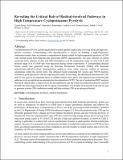Revealing the critical role of radical-involved pathways in high temperature cyclopentanone pyrolysis
Author(s)
Dong, Xiaorui; Ninnemann, Erik; Ranasinghe, Duminda S; Laich, Andrew; Greene, Robert; Vasu, Subith S.; Green Jr, William H; ... Show more Show less
DownloadCPO_comb_n_flame_final_wohl.pdf (2.777Mb)
Publisher with Creative Commons License
Publisher with Creative Commons License
Creative Commons Attribution
Terms of use
Metadata
Show full item recordAbstract
Cyclopentanone (CPO) is a promising biofuel for spark-ignition engines due to its ring strain and high auto-ignition resistance. Understanding CPO decomposition is crucial for building a high-temperature combustion model. Here we present a comprehensive kinetic model for high-temperature pyrolysis of CPO with verified results from high-pressure shock tube (HPST) measurements. The time-histories of carbon monoxide (CO), ethylene (C₂H₄), and CPO absorbances over the temperature range of 1156–1416 K and pressure range of 8.53–10.06 atm were measured during current experiments. A corresponding detailed kinetic model was generated using the Reaction Mechanism Generator (RMG) with dominant unimolecular/radical-involved decomposition pathways from either previous studies or quantum calculations within the current work. The obtained model containing 821 species and 79,859 reactions exhibited a good agreement with the experimental results. In this study, the absorbance ratio between C₂H₄ and CO was used as an important factor to validate models and to prove that radical-involved bimolecular pathways were as significant as unimolecular decomposition of CPO. The rate of production (ROP) analysis showed H radicals play a major role in the decomposition, and the whole decomposition process could be divided into three stages based on the H radical concentration. The insights from present work can be used to generate a better CPO combustion model and help evaluate CPO as an advanced biofuel.
Date issued
2020-06Department
Massachusetts Institute of Technology. Department of Chemical EngineeringJournal
Combustion and Flame
Publisher
Elsevier BV
Citation
Dong, Xiaorui et al. "Revealing the critical role of radical-involved pathways in high temperature cyclopentanone pyrolysis." Combustion and Flame 216 (June 2020): 280-292 © 2020 The Combustion Institute
Version: Author's final manuscript
ISSN
0010-2180